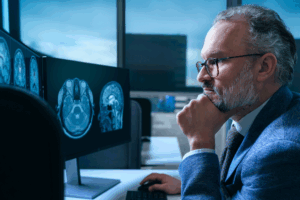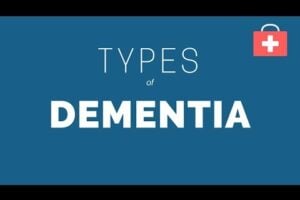SMARTPHONE DIAGNOSTICS VIDEO + ARTICLE:
Researchers have developed a smartphone app that could allow people to screen for Alzheimer’s and other disorders by recording closeups of their eye. Check it out!
Researchers at the University of California San Diego have developed a smartphone app that could allow people to screen for Alzheimer’s disease, ADHD and other neurological diseases and disorders—by recording closeups of their eye.
The app uses a near-infrared camera, which is built into newer smartphones for facial recognition, along with a regular selfie camera to track how a person’s pupil changes in size. These pupil measurements could be used to assess a person’s cognitive condition.
The technology is described in a paper that was presented at the ACM Computer Human Interaction Conference on Human Factors in Computing Systems (CHI 2022), which will take place from April 30 to May 5 in New Orleans as a hybrid-onsite event.
Intro to smartphone diagnostics
“While there is still a lot of work to be done, I am excited about the potential for using this technology to bring neurological screening out of clinical lab settings and into homes,” said Colin Barry, an electrical and computer engineering Ph.D. student at UC San Diego and the first author of the paper, which received an Honorable Mention for Best Paper award.
“We hope that this opens the door to novel explorations of using smartphones to detect and monitor potential health problems earlier on.”
Pupil size can provide information about a person’s neurological functions, recent research has shown. For example, pupil size increases when a person performs a difficult cognitive task or hears an unexpected sound.
Future test for Alzheimer’s
Measuring the changes in pupil diameter is done by performing what’s called a pupil response test.
The test could offer a simple and easy way to diagnose and monitor various neurological diseases and disorders. However, it currently requires specialized and costly equipment, making it impractical to perform outside the lab or clinic.
Engineers in the Digital Health Lab, led by UC San Diego electrical and computer engineering professor Edward Wang, collaborated with researchers at the UC San Diego Center for Mental Health Technology (MHTech Center) to develop a more affordable and accessible solution.
“A scalable smartphone assessment tool that can be used for large-scale community screenings could facilitate the development of pupil response tests as minimally-invasive and inexpensive tests to aid in the detection and understanding of diseases like Alzheimer’s disease. This could have a huge public health impact,” said Eric Granholm, a psychiatry professor at UC San Diego School of Medicine and director of the MHTech Center.
How it works
The app developed by the UC San Diego team uses a smartphone’s near-infrared camera to detect a person’s pupil.
In the near-infrared spectrum, the pupil can be easily differentiated from the iris, even in eyes with darker iris colors.
This enables the app to calculate pupil size with sub-millimeter accuracy across various eye colors.
The app also uses a color picture taken by the smartphone’s selfie camera to capture the stereoscopic distance between the smartphone and the user.
The app then uses this distance to convert the pupil size from the near-infrared image into millimeter units.
A strong start
The app’s measurements were comparable to those taken by a device called a pupillometer, which is the gold standard for measuring pupil size.
The researchers also included various features in their app to make it more user friendly for older adults.
“For us, one of the most important factors in technology development is to ensure that these solutions are ultimately usable for anyone. This includes individuals like older adults who might not be accustomed to using smartphones,” said Barry.
Designed for older adults
The researchers worked with older adult participants to design a simple app interface that allows users to self administer pupil response tests. This interface included voice commands, image-based instructions, and a cheap, plastic scope to direct the user to place their eye within the view of the smartphone camera.
“By testing directly with older adults, we learned about ways to improve our system’s overall usability and even helped us innovate older adult specific solutions that make it easier for those with different physical limits to still use our system successfully,” said Wang, who is also a faculty member in the UC San Diego Design Lab.
“When developing technologies, we must look beyond function as the only metric of success, but understand how our solutions will be utilized by end-users who are very diverse.”
The Digital Health Lab is continuing this work in a project to enable similar pupillometry function on any smartphone rather than just the newer smartphones.
Future studies will also involve working with older adults to evaluate home use of the technology. The team will work with older individuals with mild cognitive impairment to test the app as a risk screening tool for early stage Alzheimer’s disease.
MORE INFO:
- This work was funded by the National Institute of Aging.
SOURCE:
REFERENCE:
- Colin Barry, Jessica de Souza, Yinan Xuan, Jason Holden, Eric Granholm, Edward Jay Wang. At-Home Pupillometry using Smartphone Facial Identification Cameras. CHI ’22: CHI Conference on Human Factors in Computing Systems, April 2022 Article No.: 235, Pages 1–12. DOI: 10.1145/3491102.3502493











